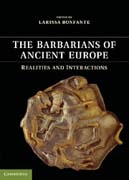
The Barbarians of Ancient Europe deals with the reality of the indigenous peoples of Europe, in contrast to many publications that explore these peoples in the context of the Greek idea of 'barbarians' as the 'Other'. These varied groups - Thracians, Scythians, Celts, Germans, Etruscans, and other peoples of Italy, the Alps, and beyond - had contact with one another and with Greek culture during its flowering. Images on the spectacular gold and silver objects buried in royal tombs show how the horse-riding nomads and the barbarian women warriors known in antiquity as Amazons saw themselves. Archaeological discoveries show how they dressed, what they ate and drank, where they lived, and how they honored their dead kings with barbaric splendor and human sacrifices, allowing us to change, correct, or confirm the picture given in Greek and Roman literature. INDICE: 1. Classical and barbarian Larissa Bonfante; 2. Greek geography of western barbarians Paul Keyser; 3. The funeral of Scythian kings: the historical reality and the description of Herodotus (4.71–72) Askold Ivantchik; 4. Scythians: between mobility, tomb architecture and early urban structures Renate Rolle; 5. Philomele's tongue: pictorial language of myth in ancient Thrace Ivan Marazov; 6. In the fabulous Celtic twilight Barry Cunliffe; 7. The ancient Germans Peter S. Wells; 8. Etruscans and mediators between barbarians and classical civilization Larissa Bonfante; 9. The world of situla art Otto-Herman Frey; 10. A barbarian myth? The case of the talking head Nancy Thomson de Grummond; 11. Romans and/as barbarians John Marincola; 12. Late barbarians and wine Walter Stevenson; 13. Some final thoughts Barry Cunliffe.
- ISBN: 978-1-107-69240-4
- Editorial: Cambridge University Press
- Encuadernacion: Rústica
- Páginas: 435
- Fecha Publicación: 28/04/2014
- Nº Volúmenes: 1
- Idioma: Inglés
